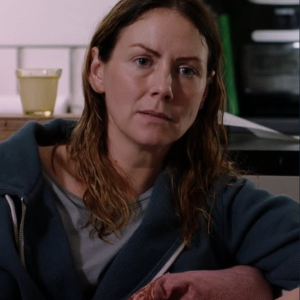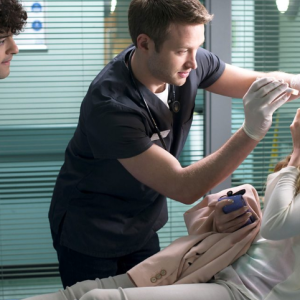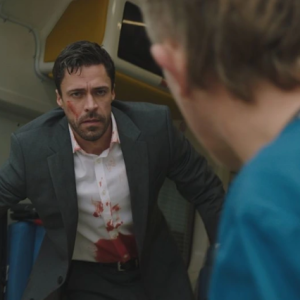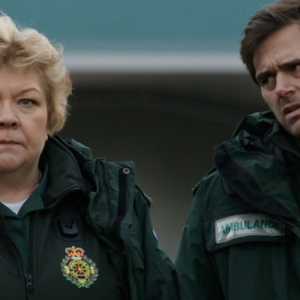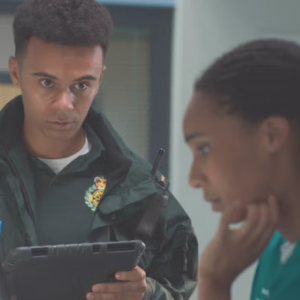Casualty: Storm Damage has arrived as a bold, unflinching and emotionally devastating miniseries that not only reinvents the long-running BBC medical drama but also reminds audiences why it remains one of the most powerful pieces of British television. With twelve tightly written episodes and the debut of Roxan Harvey as executive producer, the series was under immense scrutiny—fans were wary of losing the show’s heart when John Sen stepped down. Yet, Storm Damage has silenced every doubt, delivering storytelling that is as raw as it is profound, offering character-driven narratives with stakes higher than ever before. The central theme is the destructive force of a storm that ravages Holby’s ED, both literally and metaphorically. The first three episodes immerse viewers in chaos, with patients flooding in from collapsed homes, paramedics navigating streets littered with wreckage, and exhausted staff making impossible decisions. But where Storm Damage truly excels is in its aftermath—examining how trauma lingers, how the ripple effects of disaster spread into private lives, and how individuals either break or grow stronger under pressure. This dual structure allows the miniseries to transcend the disaster genre, evolving into a layered exploration of human resilience.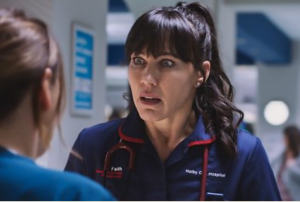
The breakout arc belongs to Nurse Cam, played by Barney Walsh, who faced skepticism at first due to his famous lineage but quickly silenced critics with a performance so raw it’s impossible to ignore. His storyline—centered on historic sexual abuse and the re-emergence of his abuser Jamie—is one of Casualty’s bravest narrative risks in years. What begins as subtle unease develops into a harrowing confrontation, not for spectacle but for truth and healing. The climax does not arrive with Cam forcing Jamie to confess but in his decision to reclaim power through solidarity with fellow survivor Bobby, an ending both haunting and uplifting. Walsh’s nuanced portrayal transforms Cam into one of the show’s most memorable characters in recent history, a testament to the series’ ability to marry social relevance with compelling drama. Meanwhile, Siobhan breaks new ground as the first nurse clinical lead in Casualty’s thirty-seven-year run. Her authority is tested not only in the ED but in her personal life when her firefighter husband Rich betrays her with none other than consultant Stevie Nash. The reveal shatters fans mid-series, reframing every interaction between the women with layers of bitterness and betrayal. The final moments of Storm Damage leave Siobhan devastated yet defiant, her fragile marriage in tatters, her professional role intact, and her simmering conflict with Stevie promising storylines of explosive intensity when the show returns.
Elsewhere, Dr Nicole’s journey provides one of the series’ most heart-wrenching emotional anchors. Acting as a surrogate for Rosie, Nicole faces a moral and emotional labyrinth when the baby is born with Down syndrome. The scenes are devastating in their intimacy, with Nicole torn between maternal attachment and the painful duty of letting go. When she hands over the child she longed to raise, the heartbreak is palpable, yet the story does not end in despair. Instead, her slow-burning romance with Nooi blossoms, offering a delicate thread of hope amid tragedy. Jacob and his son Blake’s storylines add further depth, confronting mental health and hereditary schizophrenia with sensitivity and realism, their bond portraying the struggles of fatherhood and legacy with quiet emotional weight. Other arcs, such as Iain and Faith rekindling unity after conflict and Jodie and Teddy’s turbulent romance collapsing under poor decisions, flesh out the tapestry of ED life, showing how personal and professional crises collide relentlessly.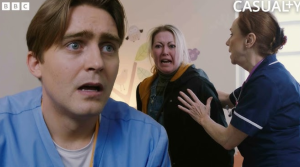
One of the most unforgettable subplots belongs to Dylan Kog, the eccentric consultant whose world is shaken when his beloved dog Derer is diagnosed with a terminal tumor. After more than a decade together, Dylan’s decision to euthanize his companion is staged with raw vulnerability, breaking the hearts of viewers as William Beck delivers one of his finest performances to date. The grief is visceral, yet the writers balance it with the tentative bloom of new love, as Dylan forms a fragile connection with nurse Sophia. This duality—loss and renewal, despair and tenderness—captures the essence of Storm Damage as a whole. It is a series unafraid to devastate, yet equally determined to heal. These personal stories, interwoven with the chaos of the storm and its aftermath, create a rhythm that never allows viewers to disengage. Every beat feels purposeful, every tear earned, every revelation perfectly timed.
Ultimately, Storm Damage is proof that Casualty thrives in the miniseries format. By condensing the drama into twelve episodes, the show gains intensity, cinematic scale, and narrative sharpness without sacrificing the intimacy of character work. Roxan Harvey’s debut as executive producer is nothing short of triumphant, steering the show into daring, emotionally resonant territory that will undoubtedly influence its future direction. Performances from Barney Walsh and William Beck stand out as career-defining, while the writing elevates familiar characters into unforgettable territory. As the series signs off until Christmas, fans are left shaken, inspired, and desperate for more—especially after a chilling teaser hinting that danger still looms over the paramedics. Storm Damage is not just another Casualty storyline; it is a landmark in the show’s history, a fearless reinvention that proves Casualty remains unmatched in its ability to combine medical crisis with human drama. It hits hard, lingers long after the credits roll, and ensures that even after nearly four decades, Casualty is still capable of surprising us, challenging us, and breaking our hearts.
